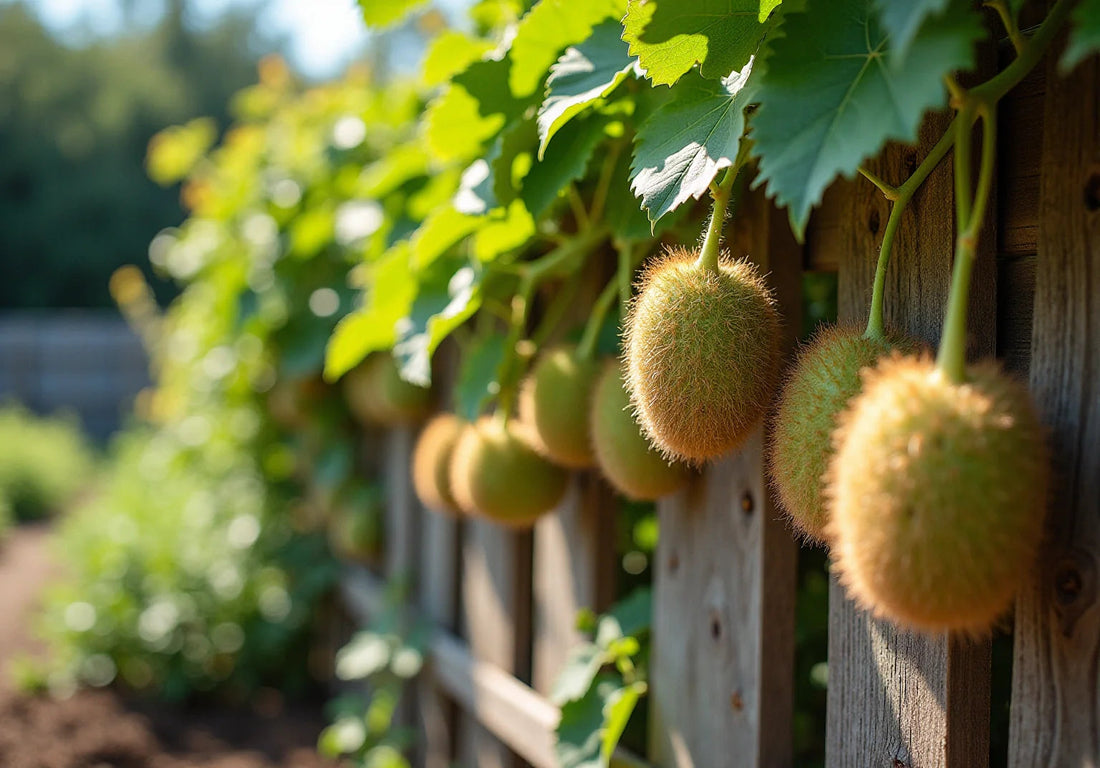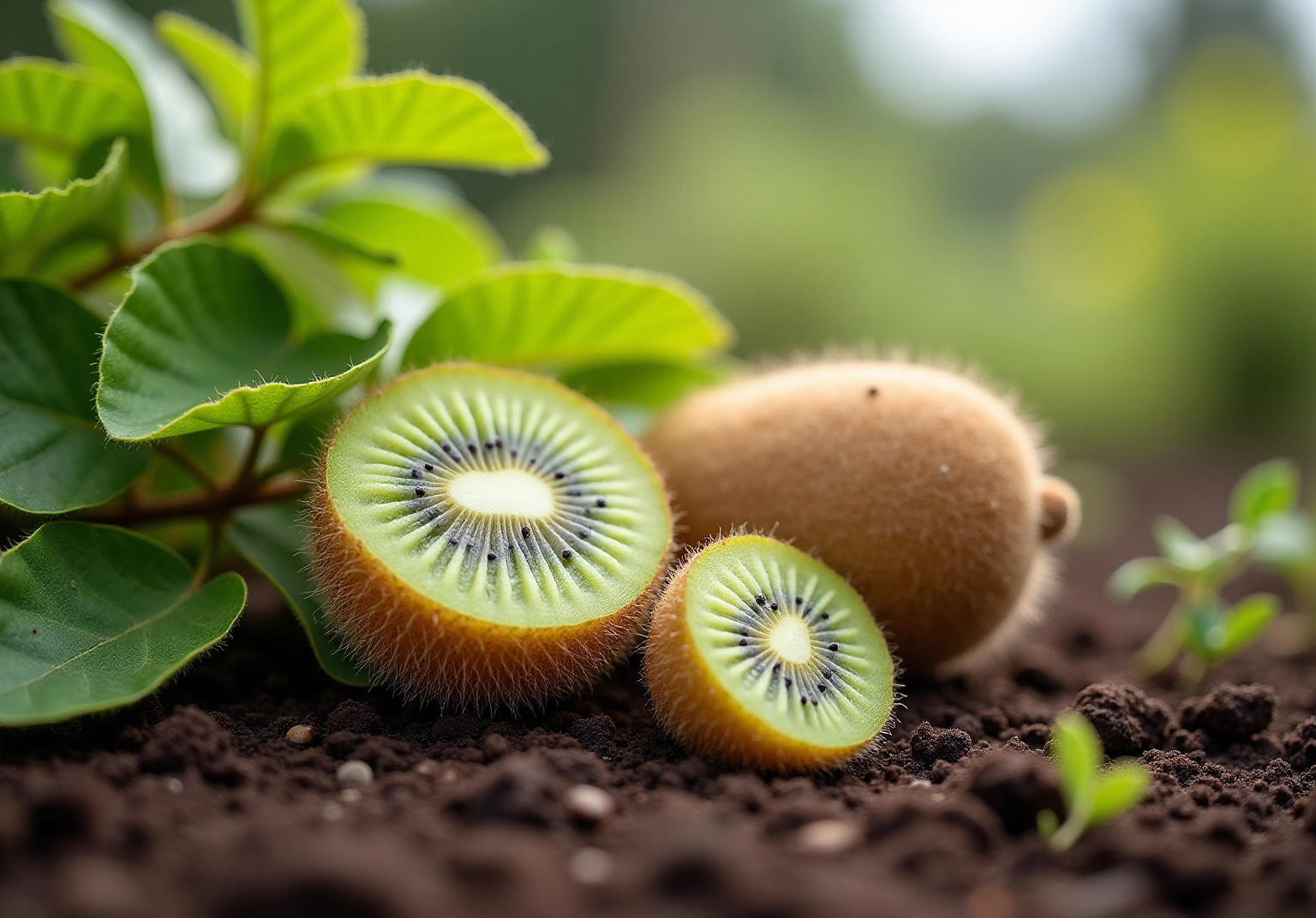
Hardy Kiwi vs Fuzzy Kiwi: Growth, Taste, and Care Insights
Share
The world of kiwifruit presents a fascinating dichotomy between the hardy kiwi and the fuzzy kiwi, each offering unique characteristics that cater to different gardening environments and taste preferences.
- Hardy kiwis, featuring small, fuzzless berries, thrive in cooler climates and require less maintenance, making them an appealing choice for novice gardeners.
- Conversely, fuzzy kiwis, known for their larger, hairy fruits, demand warmer conditions and more care; however, they deliver a distinct flavor that many find irresistible.
As home gardeners increasingly seek resilient and rewarding fruit options, the question arises: which kiwi variety reigns supreme in terms of growth, taste, and care?
🥝 Want to grow a kiwi plant in your garden?
Overview of Hardy Kiwi and Fuzzy Kiwi
Hardy Actinidia arguta, commonly known as kiwiberry, is a small, fuzzless berry typically the size of a grape, celebrated for its exceptional cold resistance. Thriving in USDA zones 3 to 8, it is particularly well-suited for cooler climates and can produce fruit within one to three years of planting. In contrast, the hairy fruit (Actinidia deliciosa), which is larger and more textured, is the variety most commonly found in grocery stores. This variety requires warmer conditions (zones 7 to 9) and a longer growing season to reach maturity.
Although both the hardy kiwi vs fuzzy kiwi belong to the same genus, they display distinct physical characteristics, flavor profiles, and growing requirements. The comparison of hardy kiwi vs fuzzy kiwi shows that hardy kiwi is renowned for its sweet, grape-sized fruit that can be eaten whole, while fuzzy kiwi is recognized for its larger size and soft exterior, offering a unique texture and flavor experience.
Market trends indicate a growing interest in resilient fruit among home gardeners, particularly in cooler climates, due to its durability and lower maintenance needs. Horticulturists emphasize that the versatility of hardy kiwi makes it an excellent choice for novice growers, as it requires less intensive care compared to its softer counterpart. Research underscores that while soft-fleshed kiwifruit thrives in warmer regions, robust kiwifruit can flourish in diverse environments, making it a flexible option for various gardening scenarios.
Successful gardening experiences with fuzzy fruit have emerged in warmer regions, where gardeners appreciate its rich flavor and larger fruit size. However, it is essential to provide proper care, including adequate support structures and pruning techniques, to maximize yield and maintain plant health. Ultimately, understanding the differences between hardy kiwi vs fuzzy kiwi allows gardeners to make informed choices that align with their climate and gardening objectives.

Growth Requirements: Hardy Kiwi vs Fuzzy Kiwi
Hardy actinidia exhibits remarkable resilience, capable of withstanding temperatures as low as -25°F when dormant. This feature allows it to thrive in various climates, particularly in well-drained, fertile soil, where it requires full sun—at least six hours of direct sunlight daily. In contrast, when discussing hardy kiwi vs fuzzy kiwi, the soft fruit variety is less cold-hardy, tolerating temperatures only down to about 10°F. While it also prefers well-drained soil, this type of fruit is more sensitive to waterlogged conditions, which can significantly hinder its growth.
The soft fruit demands a longer growing season of approximately 225-240 frost-free days, making it less suitable for northern climates where such conditions are rare. When comparing hardy kiwi vs fuzzy kiwi, both types benefit from trellising to support their vigorous growth; however, hardy fruit is generally more forgiving in less-than-ideal conditions, providing greater flexibility in cultivation. Additionally, fuzzy fruit requires specific chill hours for optimal production, which can pose a challenge in colder regions.
It is important to note that hardy fruit is regarded as invasive in certain areas, a significant aspect for gardeners to consider when planning their cultivation. Understanding these characteristics allows gardeners to make informed decisions about which variety to plant based on their local climate and soil conditions.

Taste Comparison: Flavor Profiles of Hardy Kiwi and Fuzzy Kiwi
Hardy fruit is celebrated for its sweetness, with sugar levels reaching up to 20 percent and lower acidity, offering a flavor profile that combines hints of banana, pear, and strawberry. This fruit's smooth skin allows for whole consumption without the need for peeling, enhancing the overall eating experience. In contrast, green fruit presents a tangy flavor with a more pronounced acidity, making it a favored ingredient in desserts and salads. The texture of soft green fruit is defined by its hairy exterior and succulent interior, resulting in a unique mouthfeel. While both varieties offer distinct flavor experiences, the choice between hardy kiwi vs fuzzy kiwi often depends on personal preferences—whether one enjoys the sweetness of robust fruit or the tartness of fuzzy fruit.
Recent consumer preference studies indicate a growing appreciation for the taste of robust fruit, particularly among chefs who value its versatility in various culinary applications. Furthermore, resilient fruit thrives in full sunlight and well-drained earth, making it an attractive option for home gardeners. However, potential challenges such as the need for proper pruning and the risk of wildlife interference should be considered when cultivating these varieties.

Care and Maintenance: Best Practices for Hardy and Fuzzy Kiwi
Both resilient and soft fruits require regular trimming to maintain their shape and encourage fruiting. When comparing hardy kiwi vs fuzzy kiwi, it is important to note that:
- Hardy kiwifruit should be pruned in late winter or early spring.
- Fuzzy kiwifruit benefits from summer pruning to manage growth effectively.
It is advisable to prune lateral canes, leaving 15 to 20 canes across the vine's cordons.
Fertilization plays a crucial role in the health of these plants; the hardy kiwi vs fuzzy kiwi shows that:
- Resilient fruit prefers a slightly acidic soil pH of 5-6.5.
- The fuzzy variety can thrive in a broader pH range.
Conducting soil tests for hardy fruit is encouraged to ensure optimal growing conditions. Both types require consistent watering, particularly during dry spells, but care must be taken to avoid overwatering, which can lead to root rot.
Furthermore, it is essential to have one male plant for every 5-6 female plants to ensure fruit production, as noted by Dr. Gary Y. Gao. Pest management is vital for both varieties, with common pests including aphids and spider mites. Regular monitoring and the application of organic pest control methods can help maintain plant health. Additionally, maintaining pruning tools is critical to prevent the spread of diseases.
By adhering to these best practices, gardeners can promote robust growth and fruitful yields from their kiwi plants.

Conclusion
The exploration of hardy kiwi versus fuzzy kiwi reveals a fascinating contrast between these two varieties, each with its unique attributes and requirements. Hardy kiwi, known for its cold resilience and sweet, grape-sized fruit, offers an excellent choice for gardeners in cooler climates. In contrast, fuzzy kiwi, with its larger, tangy fruit, thrives in warmer regions, showcasing the diversity within the kiwifruit family.
Key insights highlight the distinct growth needs and flavor profiles of both varieties:
- Hardy kiwi flourishes in a range of conditions, requiring less maintenance and proving to be a robust option for novice gardeners.
- Fuzzy kiwi demands a longer growing season and specific care practices to yield its delicious fruit.
Understanding these differences aids gardeners in selecting the right variety based on their local climate and personal taste preferences.
Ultimately, the choice between hardy kiwi and fuzzy kiwi goes beyond mere preference; it reflects a gardener's adaptability to their environment and their desire for resilient, flavorful fruits. Embracing the unique characteristics of each variety can lead to rewarding gardening experiences and delightful culinary adventures. For those looking to diversify their home gardens, considering the benefits and care tips for both hardy and fuzzy kiwi may pave the way for fruitful outcomes and an enriched gardening journey.
Cultivate Your Garden with the Right Kiwi for Your Climate!
Discover the unique benefits of hardy and fuzzy kiwi and start your fruitful journey today with Everglades Farm.
👉🏻 Explore Prolific Kiwi Hardy Plant and Issai Kiwi
👉🏻 All Fruit Trees Collection
Frequently Asked Questions
What is hardy kiwi and how does it differ from fuzzy kiwi?
Hardy kiwi, or Actinidia arguta, is a small, fuzzless berry known for its cold resistance and is typically the size of a grape. In contrast, fuzzy kiwi, or Actinidia deliciosa, is larger, has a hairy exterior, and is commonly found in grocery stores.
What are the growing conditions for hardy kiwi?
Hardy kiwi thrives in USDA zones 3 to 8, making it well-suited for cooler climates. It can produce fruit within one to three years of planting.
What are the growing conditions for fuzzy kiwi?
Fuzzy kiwi requires warmer conditions, specifically USDA zones 7 to 9, and has a longer growing season to reach maturity.
What are the main flavor differences between hardy kiwi and fuzzy kiwi?
Hardy kiwi is known for its sweet, grape-sized fruit that can be eaten whole, while fuzzy kiwi offers a unique texture and flavor experience due to its larger size and soft exterior.
Why is there a growing interest in hardy kiwi among home gardeners?
There is a growing interest in hardy kiwi due to its durability, lower maintenance needs, and suitability for cooler climates, making it an excellent choice for novice growers.
What care is required for fuzzy kiwi to maximize yield?
Fuzzy kiwi requires proper care, including adequate support structures and specific pruning techniques, to maximize yield and maintain plant health.
How do hardy kiwi and fuzzy kiwi perform in different environments?
Hardy kiwi can flourish in diverse environments and is more flexible in terms of growing conditions, while fuzzy kiwi thrives primarily in warmer regions.
How can understanding the differences between hardy kiwi and fuzzy kiwi help gardeners?
Understanding the differences allows gardeners to make informed choices that align with their specific climate and gardening objectives, ensuring better success in growing these fruits.

